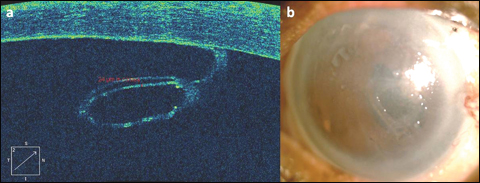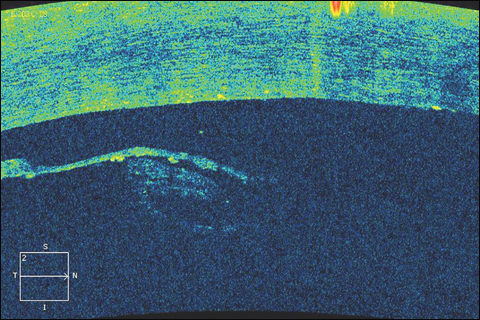‘Computer mouse sign’ may predict inverted endothelial graft
Corneal endothelial decompensation has been treated successfully by endothelial keratoplasty techniques. Intrinsic properties of the host and multiple factors in the graft play a role in graft adherence. Graft detachments and positional problems are often detected clinically or by anterior segment OCT. Although OCT has been used for analysis of the graft, there have been no clear patterns described for detachments or inverted grafts. We have described a unique configuration in the form of a computer mouse that is seen in patients with a tight scroll, which often is difficult to unroll and requires graft removal.
Mouse sign in OCT
“Mouse sign” is described in relation to the configuration of a computer mouse. This sign is seen only by OCT, preferably by spectral or Fourier domain OCT. Spectral domain OCT has a resolution of 5 µm and shows a clear pattern with an endothelial graft. We used Cirrus 5000 spectral domain OCT (Carl Zeiss Meditec) to examine postoperative patients after pre-Descemet’s endothelial keratoplasty. Fourier domain OCT showed a detached graft involving the partial central and inferior cornea with the convex configuration (Figure 1) and one end still attached to the cornea like a “computer mouse.” The partial attachment of the graft and the end scroll give the mouse configuration. We noticed such a pattern in five eyes of patients who underwent PDEK and seemed to have an inverted graft. All five patients had unsuccessful re-bubbling and had graft exchanges.
Case scenarios

Images: Agarwal A

A 60-year-old woman underwent PDEK, and the immediate postoperative period showed good graft adherence. Slit lamp examination on postoperative day 10 revealed diffuse stromal edema, Descemet’s folds and rolled graft detachment centrally. Fourier domain OCT showed detached graft involving the partial central and inferior cornea with a convex configuration (Figure 1) and one end still attached to the cornea like a computer mouse. The patient underwent re-bubbling; however, re-detachment occurred, which finally required graft exchange.
A 59-year-old man who underwent PDEK surgery for pseudophakic bullous keratopathy attended our outpatient follow-up. Slit lamp examination revealed diffuse stromal edema and graft detachment centrally and inferiorly on postoperative day 2. Fourier domain OCT showed a detached and inverted convex graft in the anterior chamber (mouse sign) (Figure 2). The patient underwent re-bubbling with air in an attempt to reattach the graft. Follow-up on day 8 showed an epithelial defect, diffuse corneal edema and a detached graft. The patient underwent graft exchange in the same eye on follow-up.
A 67-year-old woman who underwent PDEK for pseudophakic bullous keratopathy did not have improvement in visual acuity for 1 week postoperatively. Clinical examination showed dense corneal edema, and further anterior chamber details were not visible. OCT evaluation of the operated eye showed a detached graft with mouse sign. The patient underwent graft exchange.
Etiology for mouse configuration
The configuration of a “mouse sign” was seen in all patients with a thick scroll that showed difficulty in unrolling and recurrent detachment in the same configuration after repeat air injection. The probable reasons for this include uncorrected rolled or curled edges at the end of surgery; insufficient air support inside the chamber; inverse graft positioning; and stromal irregularities or incomplete recipient Descemet’s membrane removal. Graft edema, tight scroll and premature loss of air support may also be the probable reasons for this configuration. The early stage of mouse sign will show a convex configuration, which subsequently detaches and forms the full-fledged mouse sign. Although the influence of donor age on the graft configuration cannot be ruled out, the age in the PDEK group varied from young to adult donors. The attempts at re-bubbling failed in all cases, as the graft regained the same configuration each time after manipulation.
Graft adhesion
Factors favoring the attachment of a graft to the host cornea include a stable, well-formed anterior chamber morphology and chamber pressure, which is achieved by adequate air fill of about 80%. Higher donor age due to easy unrolling of the graft and postoperative supine position have also been known to help adherence. Factors favoring graft displacement are incomplete host epithelial Descemet’s membrane removal and residual anterior band layer fragments. In situ glaucoma drainage devices, post-trabeculectomy blebs and previous vitrectomy are additional causes for graft detachments. Graft reversal occurs when the endothelium side of the donor graft faces the host cornea while the Descemet’s membrane faces the iris-lens diaphragm. There are many techniques suggested to identify and avoid graft reversal intraoperatively, including bimanual infusion technique, endoilluminator-assisted endothelial keratoplasty, F mark, intraoperative OCT, S mark, triangular mark, taco configuration and Venn diagram.
Conclusion
Graft detachment in the early postoperative period can happen after endothelial keratoplasty. Routine anterior segment Fourier domain OCT can be used for evaluation of these patients. “Mouse sign” can be a predictor of an inverted graft and indicate that re-bubbling may not be successful in such eyes. Graft exchange will be required subsequently for rapid visual rehabilitation.
- References:
- Agarwal A, et al. Br J Ophthalmol. 2014;doi:10.1136/bjophthalmol-2013-304639.5.
- Bhogal M, et al. J Cataract Refract Surg. 2015;doi:10.1016/j.jcrs.2015.08.005.
- Brockmann T, et al. Acta Ophthalmol. 2014;doi:10.1111/aos.12419.
- Busin M, et al. Ophthalmology. 2013;doi:10.1016/j.ophtha.2012.11.030.
- Dapena I, et al. Ophthalmology. 2010;doi:10.1016/j.ophtha.2009.09.054.
- Dirisamer M, et al. Arch Ophthalmol. 2012;doi:10.1001/archophthalmol.2011.343.
- Droutas K, et al. Clin Ophthalmol. 2014;doi:10.2147/OPTH.S55396.
- Güell JL, et al. Cornea. 2013;doi:10.1097/ICO.0b013e3182933aee.
- Jacob S, et al. Clin Ophthalmol. 2015;doi:10.2147/OPTH.S95282.
- Liarakos VS, et al. JAMA Ophthalmol. 2013;doi:10.1001/2013.jamaophthalmol.4.
- Maier AK, et al. Cornea. 2016;doi:10.1097/ICO.0000000000000740.
- Nahum Y, et al. Cornea. 2015;doi:10.1097/ICO.0000000000000455.
- Ni N, et al. Cornea. 2015;doi:10.1097/ICO.0000000000000445.
- Price MO, et al. Curr Opin Ophthalmol. 2007;doi:10.1097/ICU.0b013e3281a4775b.
- Titiyal JS, et al. Cornea. 2016;doi:10.1097/ICO.0000000000000757.
- Veldman PB, et al. Ophthalmology. 2016;doi:10.1016/j.ophtha.2015.08.044.
- Yoeruek E, et al. Cornea. 2015;doi:10.1097/ICO.0000000000000288.
- For more information:
- Amar Agarwal, MS, FRCS, FRCOphth, is director of Dr. Agarwal’s Eye Hospital and Eye Research Centre. Agarwal is the author of several books published by SLACK Incorporated, publisher of Ocular Surgery News, including Phaco Nightmares: Conquering Cataract Catastrophes, Bimanual Phaco: Mastering the Phakonit/MICS Technique, Dry Eye: A Practical Guide to Ocular Surface Disorders and Stem Cell Surgery and Presbyopia: A Surgical Textbook. He can be reached at 19 Cathedral Road, Chennai 600 086, India; email: dragarwal@vsnl.com; website: www.dragarwal.com.
Disclosures: The authors report no relevant financial disclosures.
